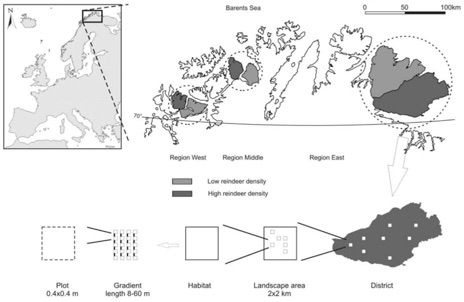study designs QUASI-EXPERIMENTAL STUDIES

Our aim is to stretch our study designs over landscapes and regions that are relevant for our predictors (such as large herbivores or climate gradients). We often find idiosyncratic responses to our predictors along these scales.


Way of choosing study units within a study design may also have consequences to the outcome of the study. We therefore advocate formal rules for choosing study units in order to at least make all choices transparent to fellow researchers and other people interested in the study outcome.
QUASI-EXPERIMENTAL STUDIES
Quasi-experimental study designs applied in
Location and the hierarchical levels of the study design. The map shows the delineation of the summer pasture districts forming the 10 pairs with contrasting reindeer densities. An arrow connects the two districts of each pair. Landscape areas of 2 km x 2 km (gray squares within the map) varied from 6 to 14 per district. Each of the landscape areas were subdivided into 100 sampling squares in which a random subsample (dark squares) was chosen. Within each selected sampling square a sampling line running from the middle of the square towards a random position at 50 m distance was established. The sampling line was analyzed every 5 m with the point intercept method by the use of a triangle with 40 cm sides with analysis pins attached in each corner.


Map depicting the location of herding districts with low and high reindeer densities in Finnmark and the spatial scales of the study design. Regional scale consists of pairs of neighboring herding districts with contrasting reindeer densities. Replicates of such adjacent districts with contrasting reindeer densities are located in three different regions of Finnmark. District and regional scales spatially coincide whereas the other scales are nested within district. Size of the habitat varies with number and length of gradients.
We believe knowledge covering such scales is a must when combining future research with monitoring and management.

Are studies in which treatments (like level of herbivore density) are chosen from existing, available “treatments” such as contrasts in herbivore densities between neighboring reindeer herding districts.
On our study design pages you will also find examples of our
EXPERIMENTAL or OBSERVATIONAL study designs.

